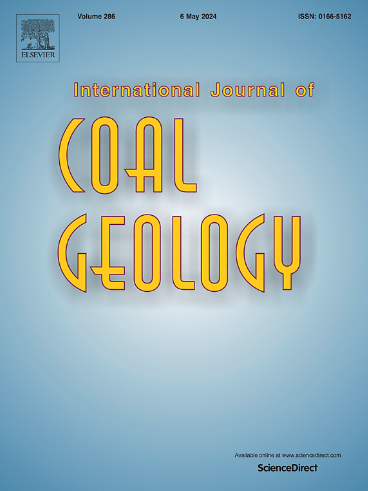A lithofacies-coupled palynofacies model for meandering river floodplains in the Late Cretaceous: Insights from the Dinosaur Park Formation, Alberta, Canada
IF 5.7
2区 工程技术
Q2 ENERGY & FUELS
引用次数: 0
Abstract
Alluvial floodplains accommodate various sub-environments that preserve evidence of fluvial dynamics, aiding in the reconstruction of terrestrial paleoenvironments. While floodplains serve as major sources and sinks for organic matter, characterizing sub-environments within ancient floodplains using fossil organic matter (kerogen) is sparsely applied due to its unclear relationship with organic matter dynamics in modern fluvial settings. This study develops a lithofacies-coupled palynofacies model for fluvial environments to address this gap and reveal organic matter dynamics in paleo-floodplains. The sedimentary successions of the Upper Cretaceous Dinosaur Park Formation in Dinosaur Provincial Park, Alberta, Canada, offer an ideal fluvial setting to develop this model, compare it across geological time intervals, and refine paleoenvironmental reconstructions of the Dinosaur Park Formation.
A floodplain-dominated stratigraphic section of the Dinosaur Park Formation comprises six recurring lithofacies and two facies associations representing channel-belt and floodplain deposits. All observed kerogen assemblages originated from terrestrial environments. Channel-belt deposits are characterized by sandstones containing opaque and amorphous non-biostructured phytoclasts, as well as amorphous organic matter. Levee deposits are characterized by sandy mudstones, while proximal floodplains are characterized by gray mudstones. Despite these distinctions, kerogen assemblages are relatively similar and heterogeneous, with opaque phytoclasts remaining prevalent. Backswamps (carbonaceous mudstones and shales) and distal floodplain environments (brown mudstones) exhibit a high abundance of cuticles, membranes, sporomorphs and amorphous non-biostructured phytoclasts. Total organic carbon content discriminates between different sub-environments, with higher organic carbon content found in backswamp and distal floodplain environments. The results show that lithofacies and kerogen assemblages (i.e. palynofacies) in the Dinosaur Park Formation's floodplains were mainly influenced by channel proximity and floodplain topography. When compared with modern and deep-time fluvial examples, the model supports palynofacies analysis as a robust proxy for distinguishing floodplain sub-environments and demonstrating its applicability in understanding fluvial dynamics over geological timescales.
晚白垩世曲流河漫滩的岩相耦合粉岩相模型:来自加拿大阿尔伯塔省恐龙公园组的启示
冲积洪积平原容纳了各种子环境,这些子环境保留了河流动力学的证据,有助于重建陆地古环境。虽然冲积平原是有机物的主要来源和汇集地,但利用有机物化石(角质)描述古代冲积平原内的亚环境却很少应用,因为它与现代河流环境中有机物动力学的关系并不明确。本研究针对这一空白,建立了一个用于河川环境的岩相耦合古生物化石模型,以揭示古洪积平原的有机质动态。位于加拿大阿尔伯塔省恐龙省立公园的上白垩统恐龙公园地层的沉积演替提供了一个理想的河流环境来建立这一模型,在不同地质年代间进行比较,并完善恐龙公园地层的古环境重建。所有观察到的角质集合体均来自陆地环境。河道带沉积的特征是砂岩,含有不透明和无定形的非生物结构植化体以及无定形有机物。堤坝沉积的特征是砂质泥岩,而近端洪泛平原的特征是灰色泥岩。尽管存在这些区别,但角质层的组合相对相似且具有异质性,不透明的植物脆皮仍然很普遍。后沼泽(碳质泥岩和页岩)和远端洪泛平原环境(褐色泥岩)展示了大量的角质层、膜、孢子体和无定形非生物结构的植化体。总有机碳含量可区分不同的亚环境,后沼泽和远洪泛区环境中的有机碳含量较高。研究结果表明,恐龙公园地层洪泛区的岩相和角质组合(即古生界)主要受河道邻近性和洪泛区地形的影响。通过与现代和深时河川实例进行比较,该模型支持将古乐彩网分析作为区分洪泛平原亚环境的可靠替代方法,并证明其适用于理解地质时空尺度上的河川动力学。
本文章由计算机程序翻译,如有差异,请以英文原文为准。
求助全文
约1分钟内获得全文
求助全文
来源期刊

International Journal of Coal Geology
工程技术-地球科学综合
CiteScore
11.00
自引率
14.30%
发文量
145
审稿时长
38 days
期刊介绍:
The International Journal of Coal Geology deals with fundamental and applied aspects of the geology and petrology of coal, oil/gas source rocks and shale gas resources. The journal aims to advance the exploration, exploitation and utilization of these resources, and to stimulate environmental awareness as well as advancement of engineering for effective resource management.
 求助内容:
求助内容: 应助结果提醒方式:
应助结果提醒方式:


